The mysteries of a lost dynasty and an emperor without a throne
By Anabel Dean
How, exactly, should one address a direct descendant of the last Austro-Hungarian Emperor, Franz Joseph I? Definitely not “Hi, mate!” or “G’day, Archie”.
The distinguished 40-year-old beneficiary of the Danube dynasty that dominated entire swathes of Central Europe – from the Middle Ages to the early 20th century – is waiting to welcome guests to his imperial mansion in the snow-capped Austrian Alps.
To live in such a place, a royal residence elevated above the amiable spa town of Bad Ischl, must be to discover a treasure every day of the year.
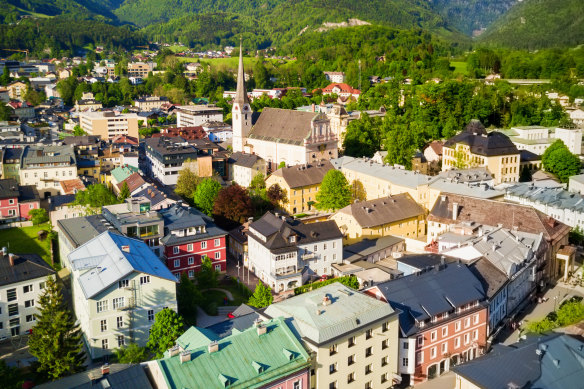
Bad Ischl… a spa town in the centre of the Salzkammergut region in Upper Austria. Credit: adobe stock
Compared to the Habsburg family’s formerly owned Hofburg and Schonbrunn palaces, in Vienna, the Kaiservilla is a miniature – neither overly ornate nor ostentatious – an exquisite wedding gift to the emperor from his mother Princess Sophie of Bavaria in 1854.
Hypnotised by the adornments of nobility, the splashing fountain writhing with classical allusions and the meadows radiant in sunshine, I am slow to notice Maximilian Habsburg-Lothringen emerge under a balcony overhung with vines.
There is no trumpet fanfare announcing my audience with the two-times great-grandson of a Habsburg emperor, just an outstretched hand, and a smile.
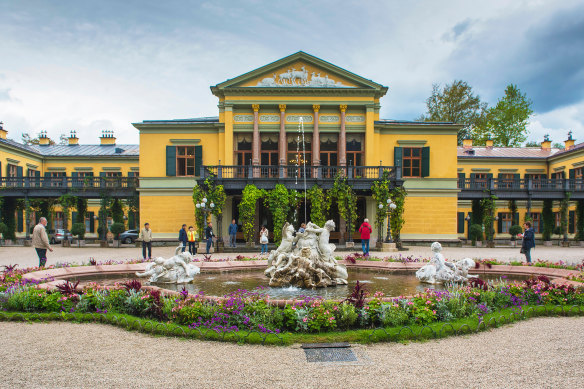
The Kaiservilla, a wedding gift to the emperor from his mother Princess Sophie of Bavaria in 1854.Credit: Adobe Stock
“Herr is fine,” explains the man in a greenish-grey loden jacket who might have been archduke. Aristocratic titles have been prohibited in Austria since the Habsburgs renounced all claims to the throne – enabling retention of the imperial villa and the private fortune – after World War I.
“So, we are just regulars,” Herr Habsburg-Lothringen discloses as we ascend a staircase spiralling heavenwards underneath a stampede of chamois heads and deer antlers mounted as trophies on the walls.
More hunting lodge than palace, and designed in the Biedermeier style, the summer retreat lies less than an hour’s drive east from Salzburg. Even by Austrian standards, this is a spectacularly scenic region, punctuated by sapphire lakes and emerald pastures. No wonder Emperor Franz Joseph I dwelled in his Kaiservilla for almost all of the 68 years that he was on the Habsburg throne.
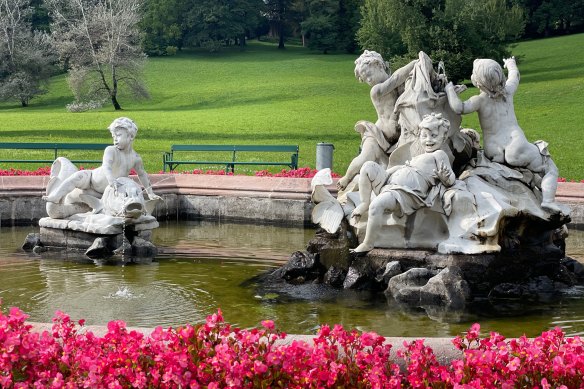
Ornate luxury… Fountain Kaiservilla.
We step on creaking parquet floors, through rooms that embody what Henry James called “the palpable, imaginable, visitable past”, unknotting the roots of his family tree.
The full cast is here, personal intimacies shared in the paintings, photographs, busts, dresses, handkerchiefs, even the simple iron bed of the emperor (standard issue for junior officers in the army barracks). Grimly, behind glass, there is the velvety cushion upon which lay the Emperor’s beautiful wife, “Sisi” Elisabeth, after being fatally stabbed by a deranged Italian anarchist in Geneva in 1898.
A polished writing desk stands in a corner of the study where Franz Joseph I completed his declaration An meine Volker (“To my people”) following the assassination of his nephew, Archduke Franz Ferdinand, heir to the Austro-Hungarian empire, on July 28, 1914. That was the piece of paper that ignited World War I. How does one comprehend the fact that such carnage could ensue from this place of extraordinary beauty ablaze with gilded light?
“That was the end of the monarchy?” I hesitate. “Yes,” replies Habsburg-Lothringen. And in that silent moment there is a sudden revelation: the 20th century changed utterly with the flourish of a fountain pen.
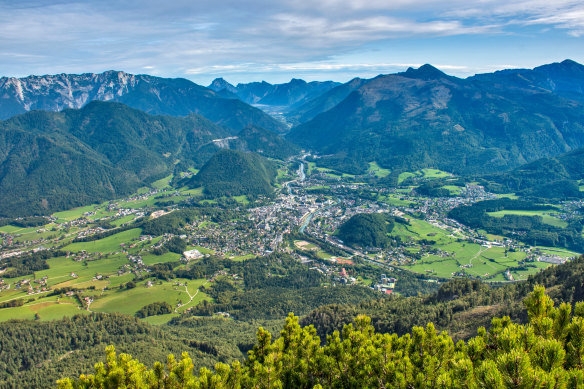
View over Bad Ischl and the Traun Valley.Credit: iStock
“Do you miss that old world?” I ask. “I’m used to it,” my host replies. “I used to live in Frankfurt. It was quite difficult. I liked it but, of course, I feel more at home in these surroundings.”
The dynasty survives, time ticks past, and the tour is too quickly over, but it’s an Indian summer afternoon so I wander through the manicured gardens of the Kaiservilla, admire the peaks and glaciers of the Dachstein. I amble over an iron bridge to the riverside town of Bad Ischl that still thrives on an intimate royal connection. Konditorei Zauner still serves the Zaunerstollen – a traditionally wonderful melange of nougat, hazelnuts and chocolate – a sweet treat that serves as prelude to “the salty” that is the other reason to visit Bad Ischl.
Salt is the white gold of the Salzkammergut. Mining this crystalised mineral stretches back more than 7000 years from Iron Age Hallstatt culture, through the Celts and Romans, to the 15th century when the Habsburgs monopolised production and so guaranteed an income for eternity.
An Altaussee salt mine, six kilometres north of nearby Bad Aussee, conceals another jewel box. This was the secret hiding place of some 10,000 masterpieces stolen from art museums across Nazi-occupied Europe that were destined for Hitler’s fantasy Fuhrermuseum in Linz.
It is a coldly clandestine chamber buried deep within a mountain, entered through a long tunnel glistening with crystals, but none of the exquisite works by Vermeer, Breughel, Durer, Rubens, Rembrandt, Picasso or Matisse are piled here today. All were recovered by Allied art historians in 1945, an heroic story immortalised in the George Clooney-directed film Monuments Men.
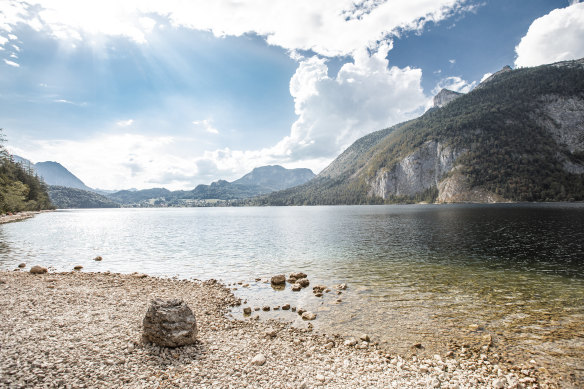
Lake Altaussee in the Salzkammergut region of Austria.
The atmosphere in this strange half-lit world is empty and dark, despite crystalline incandescence. A guide relates how the German plan to blow up the mines to stop these priceless works falling into enemy hands was thwarted by local miners, who wanted to save their livelihood, and Nazi officials who considered it a folly.
Art remains unfinished business in Austria. Some masterpieces are still awaiting repatriation but one of the greatest works, Jan van Eyck’s glorious The Adoration of the Mystic Lamb from 1432, is now back in Ghent’s St Bavo Cathedral in Belgium.
It is the world’s most stolen painting – a true survivor – just like the Habsburgs.
The writer was a guest of the Austrian National Tourist Office and Salzkammergut Tourism.
THE DETAILS
STAY
The Hotel Goldener Ochs has been offering guests comfortable accommodation in traditional style beside the river on the esplanade in Bad Ischl since 1791. goldenerochs.at
VISIT
Guided tours can be taken at The Kaiservilla with entry to the imperial gardens in a riverside location close to spectacular Mount Katrin. See kaiservilla.at/index.php/de
The Salzkammergut is a culturally diverse region of spectacular beauty. Bad Ischl on the Traun river has been selected as next year’s European Capital of Culture which, for the first time, takes place in the inner alpine region of Austria. See salzkammergut-2024.at/en/home
The Altaussee salt mine tour includes the treasure chambers, the underground lake, the chapel constructed in the salt and dedicated to St Barbara (patron saint of miners). See salzwelten.at/de/altaussee
The Center for Contemporary Craft Culture at Bad Goisern is a fascinating cultural workshop preserving traditional high-quality working crafts of the Salzkammergut. See handwerkhaus.at
EAT
There are endless opportunities for good food in pretty places. A meal at Hotel Fottinger might include a visit to Gustav Mahler’s lakeside cottage where the composer created two symphonies during the summer months (1893-96). See hotel-attersee.at
Step along the shore of Lake Attersee to relish a glass of Austrian wine at the charming Genussufer restaurant (genussufer.at) or take a flatbottomed barge (boote-salzkammergut.at) on Lake Altausseer from “Madlmair” to Restaurant Seewiese (seewiesealtaussee.at/en/).
MORE
See salzkammergut.at/en
Sign up for the Traveller Deals newsletter
Get exclusive travel deals delivered straight to your inbox. Sign up now.